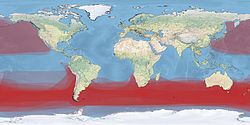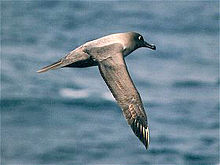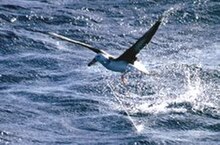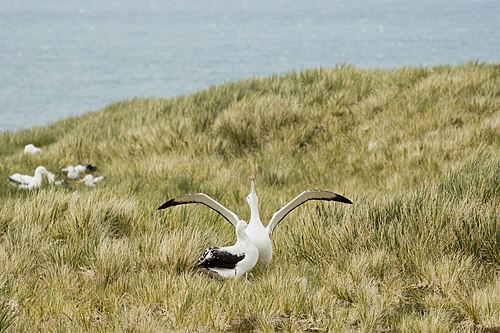Albatross
| Albatross Temporal range: Oligocene–recent
| |
|---|---|

| |
| Short-tailed albatross (Phoebastria albatrus)
Captured at Midway Atoll | |
| Scientific classification | |
| Domain: | Eukaryota |
| Kingdom: | Animalia |
| Phylum: | Chordata |
| Class: | Aves |
| Order: | Procellariiformes |
| Family: | Diomedeidae G.R. Gray 1840[1] |
| Genera | |
|
Diomedea | |

| |
| Global range density (in red)[image reference needed] | |
Albatrosses, of the biological
Albatrosses are highly efficient in the air, using
Of the 22 species of albatrosses recognised by the
Etymology
The name "albatross" is derived from the
Taxonomy and evolution
The "albatross" designation comprises between 13 and 24 species (the number is still a matter of some debate, with 21 being the most commonly accepted number) in four genera. These genera are the
The
Within the family, the assignment of genera has been debated for over 100 years. Originally placed into a single genus, Diomedea, they were rearranged by Reichenbach into four different genera in 1852, then lumped back together and split apart again several times, acquiring 12 different genus names in total (though never more than eight at one time) by 1965 (Diomedea, Phoebastria, Thalassarche, Phoebetria, Thalassageron, Diomedella, Nealbatrus, Rhothonia, Julietata, Galapagornis, Laysanornis, and Penthirenia).[6]

By 1965, in an attempt to bring some order back to the classification of albatrosses, they were lumped into two genera, Phoebetria (the sooty albatrosses, which most closely seemed to resemble the procellarids and were at the time considered "primitive" ) and Diomedea (the rest).[7] Though a case was made for the simplification of the family (particularly the nomenclature), the classification was based on the morphological analysis by Elliott Coues in 1866, and paid little attention to more recent studies and even ignored some of Coues's suggestions.[6]
Research by Gary Nunn of the American Museum of Natural History (1996) and other researchers around the world studied the mitochondrial DNA of all 14 accepted species, finding four, not two, monophyletic groups within the albatrosses. They proposed the resurrection of two of the old genus names, Phoebastria for the North Pacific albatrosses and Thalassarche for the mollymawks, with the great albatrosses retaining Diomedea and the sooty albatrosses staying in Phoebetria.[8]
While some agree on the number of genera, fewer agree on the number of species. Historically, up to 80 different taxa have been described by different researchers; most of these were incorrectly identified juvenile birds.[9]

Based on the work on albatross genera, Robertson and Nunn went on in 1998 to propose a revised taxonomy with 24 different species,
The fossil record of the albatrosses in the Northern Hemisphere is more complete than that of the Southern, and many fossil forms of albatross have been found in the North
Morphology and flight

The albatrosses are a group of large to very large birds; they are the largest of the Procellariiformes. The bill is large, strong, and sharp-edged, with the upper mandible terminating in a large hook. This bill is composed of several horny plates, and along the sides are the two "tubes", long nostrils that give the order its former name (Tubinares, or tubenoses). The tubes of all albatrosses are along the sides of the bill, unlike the rest of the Procellariiformes, where the tubes run along the top of the bill. These tubes allow the albatrosses to measure the exact airspeed in flight; the nostrils are analogous to the pitot tubes in modern aircraft. The albatross needs accurate airspeed measurement to perform dynamic soaring. Like other Procellariiformes, they use their uniquely developed sense of smell to locate potential food sources, whereas most birds depend on eyesight.[16] The feet have no hind toe and the three anterior toes are completely webbed. The legs are strong for the Procellariiformes, making them and the giant petrels the only members of that order that can walk well on land.[3]
Albatrosses, along with all Procellariiformes, must excrete the salts they ingest in drinking sea water and eating marine invertebrates. All birds have an enlarged nasal gland at the base of the bill, above their eyes. This gland is inactive in species that do not require it, but in the Procellariiformes, it acts as a salt gland. Scientists are uncertain as to its exact processes, but do know in general terms that it removes salt by secreting a 5% saline solution that drips out of their noses or is forcibly ejected.[17]

The adult plumage of most of the albatrosses is usually some variation of dark upper-wing and back with white undersides, often compared to that of a gull.[3] The extent of colouration varies: the southern royal albatross is almost completely white except for the ends and trailing edges of the wings in fully mature males, while the Amsterdam albatross has an almost juvenile-like breeding plumage with a great deal of brown, particularly a strong brown band around the chest. Several species of mollymawks and North Pacific albatrosses have face markings like eye patches or have grey or yellow on the head and nape. Three albatross species, the black-footed albatross and the two sooty albatrosses, vary completely from the usual patterns and are almost entirely dark brown (or dark grey in places in the case of the light-mantled albatross). Albatrosses take several years to get their full adult breeding plumage.[5]
The

Albatrosses combine these soaring techniques with the use of predictable weather systems; albatrosses in the
This efficient long-distance travelling underlies the albatross's success as a long-distance forager, covering great distances and expending little energy looking for patchily distributed food sources. Their adaptation to gliding flight makes them dependent on wind and waves, but their long wings are ill-suited to powered flight and most species lack the muscles and energy to undertake sustained flapping flight. Albatrosses in calm seas rest on the ocean's surface until the wind picks up again as using powered flight is not energetically worthwhile, though they are capable of flight to avoid danger.[22] The North Pacific albatrosses can use a flight style known as flap-gliding, where the bird progresses by bursts of flapping followed by gliding.[23] When taking off, albatrosses need to take a run up to allow enough air to move under the wing to provide lift.[3]
The dynamic soaring of albatrosses has provided inspiration to airplane designers;
Distribution and range at sea

Most albatrosses range in the Southern Hemisphere from
Why the albatrosses became
The use of
Ecology
Diet

The albatross diet is predominantly cephalopods, fish, crustaceans, and offal (organ meat),[3] although they also scavenge carrion and feed on other zooplankton.[3] For most species, a comprehensive understanding of diet is known for only the breeding season, when the albatrosses regularly return to land and study is possible. The importance of each of these food sources varies from species to species, and even from population to population; some concentrate on squid alone, others take more krill or fish.[29] Of the two albatross species found in Hawaii, one, the black-footed albatross, takes mostly fish, while the Laysan feeds on squid.[3]
The use of
Until recently, albatrosses were thought to be predominantly surface feeders, swimming at the surface and snapping up squid and fish pushed to the surface by currents, predators, or death. The deployment of capillary depth recorders, which record the maximum dive depth undertaken by a bird, has shown that while some species, such as the wandering albatross, do not dive deeper than a metre, some species, such as the light-mantled albatross, have a mean diving depth of almost 5 m (16 ft) and can dive as deep as 12.5 m (41 ft).[32] In addition to surface feeding and diving, they have also been observed plunge diving from the air to snatch prey.[33]
Breeding and dancing
Albatrosses are colonial, usually nesting on isolated islands; where colonies are on larger landmasses, they are found on exposed headlands with good approaches from the sea in several directions, like the colony on the Otago Peninsula in Dunedin, New Zealand. Many Buller's albatrosses and black-footed albatrosses nest under trees in open forest.[34] Colonies vary from the very dense aggregations favoured by the mollymawks (black-browed albatross colonies on the Falkland Islands have densities of 70 nests per 100 m2) to the much looser groups and widely spaced individual nests favoured by the sooty and great albatrosses. All albatross colonies are on islands that historically were free of land mammals. Albatrosses are highly philopatric, meaning they usually return to their natal colony to breed. This tendency is so strong that a study of Laysan albatrosses showed that the average distance between hatching site and the site where a bird established its own territory was 22 m (72 ft).[35]
Albatrosses live much longer than other birds; they delay breeding for longer and invest more effort into fewer young. Most species survive upwards of 50 years, the oldest recorded being a Laysan albatross named Wisdom that was ringed in 1956 as a mature adult and hatched another chick in February 2021, making her at least 70 years old. She is the oldest confirmed wild bird and the oldest banded bird in the world.[36][37]
Albatrosses reach sexual maturity slowly, after about five years, but even once they have reached maturity, they do not begin to breed for another few years (even up to 10 years for some species). Young nonbreeders attend a colony prior to beginning to breed, spending many years practising the elaborate breeding rituals and "dances" for which the family is famous.[38] Birds arriving back at the colony for the first time already have the stereotyped behaviours that compose albatross language, but can neither "read" that behaviour as exhibited by other birds nor respond appropriately.[3]
The repertoire of behaviour involves synchronised performances of various actions such as
Albatrosses are held to undertake these elaborate and painstaking rituals to ensure that the appropriate partner has been chosen and to perfect partner recognition, as egg laying and chick rearing is a huge investment. Even species that can complete an egg-laying cycle in under a year seldom lay eggs in consecutive years.[5] The great albatrosses (i.e., wandering albatross) take over a year to raise a chick from laying to fledging. Albatrosses lay a single subelliptical[18] egg, white with reddish-brown spots,[34] in a breeding season; if the egg is lost to predators or accidentally broken, then no further breeding attempts are made that year. The larger eggs weigh from 200 to 510 g (7.1 to 18.0 oz).[34] The "divorce" of a pair is a rare occurrence, due to the diminished lifetime reproductive success it causes, and usually happens only after several years of breeding failure.[5]
All the southern albatrosses create large
After hatching, the chick, which is semi-
Albatross chicks take a long time to fledge. In the case of the great albatrosses, it can take up to 280 days; even for the smaller albatrosses, it takes between 140 and 170 days.[43] Like many seabirds, albatross chicks will gain enough weight to be heavier than their parents, and prior to fledging, they use these reserves to build up body condition (particularly growing all their flight feathers), usually fledging at the same weight as their parents. Between 15 and 65% of those fledged survive to breed.[34] Albatross chicks fledge on their own and receive no further help from their parents, which return to the nest after fledging, unaware their chick has left. Studies of juveniles dispersing at sea have suggested an innate migration behaviour, a genetically coded navigation route, which helps young birds when they are first out at sea.[44]
Hybridization is rare in albatrosses, largely due to the low incidence of breeding-site vagrancy.[45]
In culture

Albatrosses have been described[by whom?] as "the most legendary of all birds".[43] An albatross is the central emblem in The Rime of the Ancient Mariner by Samuel Taylor Coleridge, representing the innocence and beauty of God's creation. The albatross metaphor is derived from this poem; someone bearing a burden or facing an obstacle is said to have "an albatross around his neck", the punishment given to the mariner who killed the albatross. A widespread myth holds that sailors believe shooting or harming an albatross is disastrous, due in part to the poem; in truth, sailors regularly killed and ate them,[25] as reported by James Cook in 1772. However, other sailors reportedly caught the birds but let them free again, possibly believing that albatrosses were the souls of lost sailors,[46] so killing them would bring bad luck.[47] The head of an albatross being caught with a hook is used as the emblem of the Cape Horners, i.e., sailors who have rounded Cape Horn on freighters under sail; captains of such ships even received themselves the title "albatrosses" in the Cape Horners' organisation.[47]
A captive albatross tormented by jeering sailors is also a metaphor for the social travails of the sensitive poète maudit in Charles Baudelaire's poem L'Albatros:
Le Poète est semblable au prince des nuées
Qui hante la tempête et se rit de l'archer;
Exilé sur le sol au milieu des huées,
Ses ailes de géant l'empêchent de marcher.
(Translation: The poet is like this prince of the clouds, who haunts the storm and mocks the archer; but exiled on earth surrounded by jeers, his giant wings make him helpless to walk.)
In
Non-European mythologies
The
Birdwatching
Albatrosses are popular birds for
Threats and conservation

In spite of often being accorded legendary status, albatrosses have not escaped either indirect or direct pressure from humans. Early encounters with albatrosses by
Of the 22 albatross species recognised by IUCN on their
On Midway Atoll, collisions between Laysan albatrosses and aircraft have resulted in human and bird deaths, as well as severe disruptions in military flight operations. Studies were made in the late 1950s and early 1960s that examined the results of control methods such as the killing of birds, the levelling and clearing of land to eliminate updrafts, and the destruction of annual nesting sites.
Another threat to albatrosses is introduced species, such as rats or feral cats, which directly attack albatrosses or their chicks and eggs. Albatrosses have evolved to breed on islands where land mammals are absent and have not developed defences against them. Even species as small as mice can be detrimental; on Gough Island, the chicks of Tristan albatrosses are attacked and eaten alive by introduced house mice.[58] Introduced species can have other indirect effects; cattle overgrazed essential cover on Amsterdam Island, threatening the Amsterdam albatross; on other islands, introduced plants reduce potential nesting habitat.[5]

Ingestion of
Scientists and conservationists (most importantly BirdLife International and their partners, who run the Save the Albatross campaign) are working with governments and fishermen to find solutions to the threats albatrosses face. Techniques such as setting longline bait at night, dyeing the bait blue, setting the bait underwater, increasing the amount of weight on lines, and using bird scarers can all reduce the seabird bycatch.[61] For example, a collaborative study between scientists and fishermen in New Zealand successfully tested an underwater setting device for longliners, which set the lines below the reach of vulnerable albatross species.[62] The use of some of these techniques in the Patagonian toothfish fishery in the Falkland Islands is thought to have reduced the number of black-browed albatrosses taken by the fleet between 1994 and 2004.[63] Conservationists have also worked on the field of island restoration, removing introduced species that threaten native wildlife, which protects albatrosses from introduced predators.
One important step towards protecting albatrosses and other seabirds is the 2001 treaty, the Agreement on the Conservation of Albatrosses and Petrels, which came into force in 2004 and has been ratified by thirteen countries, Argentina, Australia, Brazil, Chile, Ecuador, France, New Zealand, Norway, Peru, South Africa, Spain, the United Kingdom, and Uruguay.[64] The treaty requires these countries to take specific actions to reduce bycatch, pollution and to remove introduced species from nesting islands.[65]
Species
Since 1996, albatrosses have been divided into four genera. The number of species is a matter of debate. The IUCN and BirdLife International recognise 22 extant species (listed below),[2] ITIS recognise 21 (the 22 below minus T. steadi),[66] and a 2004 paper proposed a reduction to 13 (indicated in parentheses below), comprising the traditional 14 species minus D. amsterdamensis.[11]
| Image | Genus | Living species |
|---|---|---|
 |
Diomedea Linnaeus, 1758 Great albatrosses |
|
 |
Phoebastria Reichenbach, 1853 North Pacific albatrosses |
|
 |
Thalassarche Reichenbach, 1853 Mollymawks |
|
 |
Phoebetria Reichenbach, 1853 Sooty albatrosses |
|
See also
Notes
- Late Pliocene
- ^ The articles on Diomedea, Phoebastria, and Thalassarche contain more data on fossil species of living albatross genera.
References
- ^ Brands, Sheila (14 August 2008). "Systema Naturae 2000 / Classification – Family Diomedeidae". Project: The Taxonomicon. Archived from the original on 16 June 2009. Retrieved 17 February 2009.
- ^ a b c d "BirdLife Data Zone". datazone.birdlife.org. Retrieved 28 December 2022.
- ^ ISBN 1-873403-94-1.
- ISBN 0-8160-3377-3.
- ^ ISBN 0-19-850125-0
- ^ a b c Robertson, C. J. R. and Nunn, G. B. (1998) "Towards a new taxonomy for albatrosses" in: Proceedings First International Conference on the Biology and Conservation of Albatrosses, G.Robertson & R.Gales (Eds), Chipping Norton:Surrey Beatty & Sons, 13–19,
- .
- JSTOR 4088857.
- ^ a b Double, M.C. & Chambers, G.K., (2004). "The need for the parties to the Agreement on Albatrosses and Petrels (ACAP) to establish a robust, defendable and transparent decision-making process for the construction and maintenance of their species lists ". Proceedings of the Scientific Meeting of Agreement on Albatrosses and Petrels (ACAP), Hobart, Australia, 8–9 November 2004
- S2CID 28479284.
- ^ S2CID 83202756.
- S2CID 20390465.
- ^ S2CID 203891391.
- .
- ^ PMID 14566060.
- JSTOR 1368131.
- ISBN 978-0-671-65989-9.)
{{cite book}}: CS1 maint: multiple names: authors list (link - ^ ISBN 978-0-679-45123-5.
- JSTOR 2395926.
- PMID 11052538.
- ^ "Animal Facts – Albatross: Do albatrosses sleep while flying?". OnlineMathLearning.com. Retrieved 6 April 2012.
- ^ Peter Ryan (February 1997). "The Wandering Albatross" (PDF).
- ISBN 0-12-735415-8.
- ^ Daniel Stone (7 September 2012). "Albatross's Effortless Flight Decoded—May Influence Future Planes". National Geographic. Archived from the original on 9 September 2012.
- ^ ISBN 0-7011-6907-9
- ^ "No romance for lovesick albatross". 9 May 2007. Retrieved 14 May 2023.
- ^ "Albie the Albatross, world's loneliest bird, lands in Yorkshire". The Independent. 7 April 2022. Retrieved 14 May 2023.
- S2CID 28990783.
- ISBN 9780643096189. Retrieved 4 March 2021.
- S2CID 86598155.
- JSTOR 4088550.
- S2CID 129728675.
- ^ Cobley, N.D. (1996). "An observation of live prey capture by a Black-browed Albatross Diomedea melanophrys" (PDF). Marine Ornithology. 24: 45–46.
- ^ ISBN 0-7876-5784-0.
- JSTOR 4160718.
- ^ Dell'Amore, Christine (22 February 2013). "Oldest Known Wild Bird Hatches Chick at 62". National Geographic. Archived from the original on 23 February 2013. Retrieved 18 February 2017.
- ^ Arnold, Carrie (17 February 2017). "World's Oldest Wild Bird Has Baby at 66". National Geographic. Archived from the original on 19 February 2017. Retrieved 18 February 2017.
- .
- ^ Pickering, S.P.C.; Berrow, S.D. (2001). "Courtship behaviour of the Wandering Albatross Diomedea exulans at Bird Island, South Georgia" (PDF). Marine Ornithology. 29: 29–37.
- ISBN 0-949324-82-5
- ^ Warham, J. (1990) The Petrels – Their Ecology and Breeding Systems London: Academic Press.
- ^ Warham, J. (1976). "The incidence, function and ecological significance of petrel stomach oils" (PDF). Proceedings of the New Zealand Ecological Society. 24 (3): 84–93. Archived from the original (PDF) on 24 July 2006.
- ^ ISBN 84-87334-10-5
- S2CID 13962328.
- S2CID 90210611.
- ISBN 978-1-4081-3131-2.
- ^ a b From the website of the Cape Horners' organisation caphorniers.cl: A.I.C.H. Emblem. Archived 15 June 2011 at the Wayback Machine (retrieved 24 February 2011). Synthesis of an article written by the International Secretary General of the A.I.C.H., Captain Roger GHYS, as published in LE COURRIER DU CAP N°3 of December, 1999. By Rear Admiral Roberto BENAVENTE, President, Chilean Section AICH
- ^ "From Bogey to Blow-Up : Albatross". scottishgolfhistory.net. July 2003. Archived from the original on 28 June 2013.
- JSTOR 2802105.
- ^ Hor Osterlund, Holy Mōlī: Albatross and Other Ancestors, Oregon State University Press
- ^ "Short-tailed albatross (Phoebastria albatrus)". Archived from the original on 13 November 2017. Retrieved 13 November 2017.
- ISBN 0-8050-6229-7
- ISBN 978-1-904523-19-2.
- .
- PMID 35405876.
- S2CID 88307541.
- ^ Audubon Watchlist. Laysan Albatross (Phoebastria immutabilis) Archived 3 February 2008 at the Wayback Machine. audubon2.org
- ^ Amos, Jonathan (24 July 2005). Albatross chicks attacked by mice. BBC News.
- .
- ^ Auman, H.J., Ludwig, J.P., Giesy, J.P., Colborn, T., (1997) "Plastic ingestion by Laysan Albatross chicks on Sand Island, Midway Atoll, in 1994 and 1995." Archived 30 October 2005 at the Wayback Machine in Albatross Biology and Conservation, (ed by G. Robinson and R. Gales). Surrey Beatty & Sons:Chipping Norton. pp. 239–44
- ^ Food and Agriculture Organisation (1999) "The incidental catch of seabirds by longline fisheries: worldwide review and technical guidelines for mitigation" Archived 29 June 2006 at the Wayback Machine. FAO Fisheries Circular No. 937. Food and Agriculture Organisation of the United Nations, Rome.
- S2CID 86296995.
- S2CID 83077844.
- ^ Agreement on the Conservation of Albatrosses and Petrels. "Parties To ACAP". Agreement on the Conservation of Albatrosses and Petrels. Retrieved 22 January 2011.
- ^ ACAP (2009). "Amended, Third Session of the Meeting of the Parties". Agreement on the Conservation of Albatrosses and Petrels. Archived from the original on 22 June 2017. Retrieved 22 January 2011.
- ^ "Integrated Taxonomic Information System (ITIS)". Retrieved 30 October 2014.
External links
- "Diomedeidae". Integrated Taxonomic Information System.
- HANZAB complete species list (Handbook of Australian, New Zealand and Antarctic Birds.)
- BirdLife International Save the Albatross campaign
- The Agreement for the Conservation of Albatrosses and Petrels (ACAP)
- Albatross: Don Roberson's family page
- Tracking Ocean Wanderers. Archived 24 May 2011 at the Wayback Machine The global distribution of albatrosses and petrels: Results from the Global Procellariiform Tracking Workshop, 1–5 September 2003, Gordon's Bay, South Africa. BirdLife International
- Albatross videos Archived 14 March 2016 at the Wayback Machine on the Internet Bird Collection
- "Recovery plan for albatrosses in the Chatham Islands 2001–2011" (PDF). Department of Conservation, Wellington, New Zealand. 2001. Archived from the original (PDF) on 14 April 2008.


